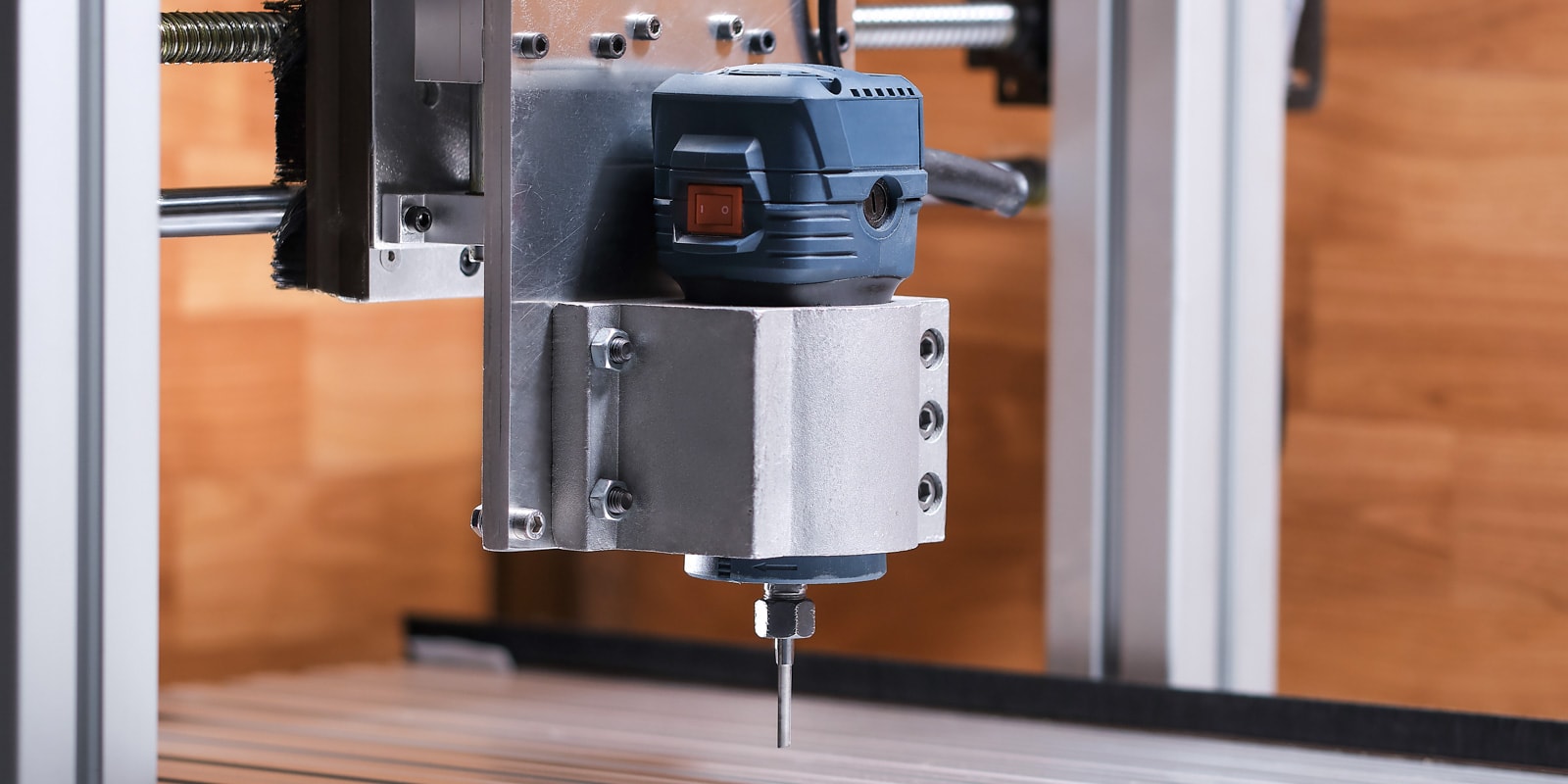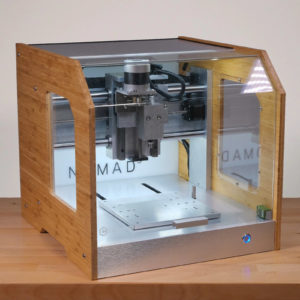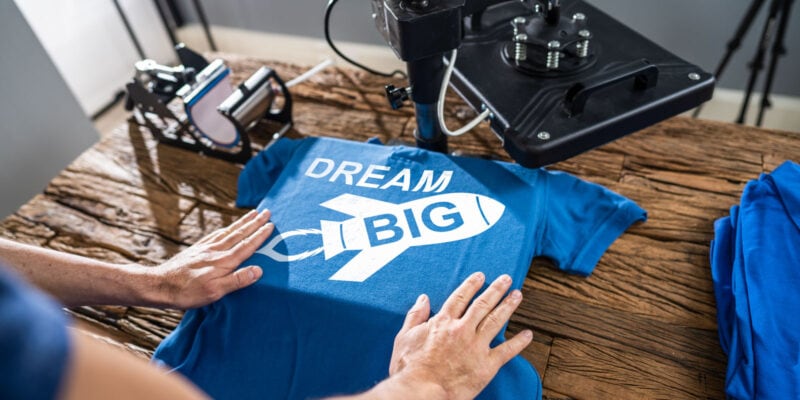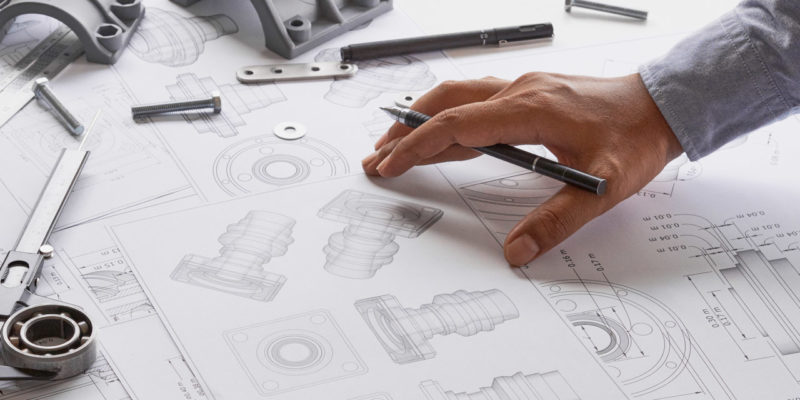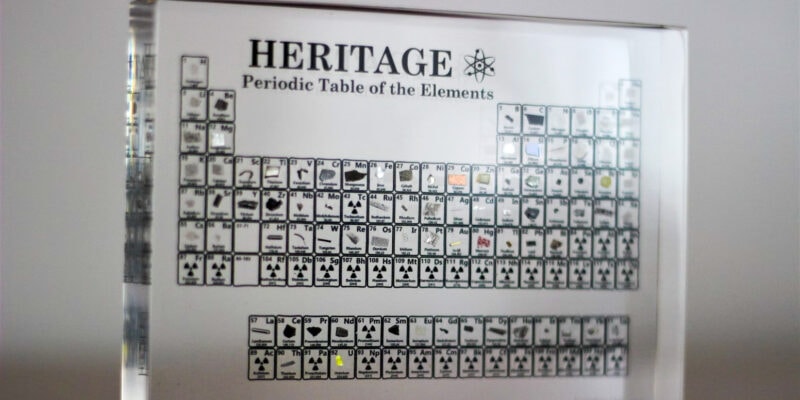In recent years, Computer Numerical Control (CNC) machines have evolved a lot in their designs, applications, and use case scenarios. You can now buy a them at a relatively affordable price and get started carving your ideas. Getting your hands on some of the best CNC routers for at home is now easier than ever, with numerous options at your disposal.
In this article, we’ll guide you through a comprehensive list of the best home CNC machines currently available in the market. But before we do that, let’s briefly go over how these machines work and what you can do with them.
| Desktop CNC Machine | Working Area | Preassembled | Price (~) | Best Offer |
|---|---|---|---|---|
| BobsCNC Evolution 4 | 610 x 610 x 85 mm | No | $1230 | |
| Carbide3D Nomad 3 | 203 x 203 x 76 mm | Yes | $2800 | |
| SainSmart Genmitsu 3018-PROVer | 260 x 155 x 35mm | Partially | $299 | |
| Inventables X-Carve | 749 x 749 x 114 mm | No | $2599 | |
| Snapmaker 2.0 | 320 x 350 x 275 mm | Partially | $1499 | |
| Carbide3D Shapeoko 4 XL | 838 x 444 x 102 mm | No | $2050 | |
| Genmitsu PROVerXL 4030 | 400 x 300 x 110 mm | Partially | $999 | |
| OpenBuilds LEAD CNC Machine 1010 | 730 x 810 x 100 mm | No | $1339+ |
What is a CNC Router?
A CNC router is an automated version of your handheld routing machine. It gives you more control over the routing process, and it lets you carve intricate designs with great details and on various materials.
Like most 3D printers, a typical CNC router works on three axes – X, Y, and Z. The X and Y axes define the machine’s cutting area, whereas the height of the Z-axis defines the depth of cut. To route the material, CNC routers also have a spindle that rotates at a high RPM.
Because the machine is controlled by a computer, you can expect more accuracy and repeatability with CNC routers than you could ever achieve by hand.
Early CNC routers used to be massive and required a large space for their operations. Nowadays, though, you can find CNC machines in a desktop form factor. While these come with a smaller working area, they are still powerful enough for home projects.
You can use a typical desktop CNC router machine for carving materials like wood, acrylic, soft aluminum, and foam. If you’re looking for a machine that can accurately work with harder materials, like steel, then you’ll need to look at more heavy-duty CNC routers.
What Can You Make With a CNC Router?
A CNC router will let you etch your designs or carve them out on your choice of material. You can use CAD/CAM software to design your models and then have your machine bring them to life. Examples of things you can make on a CNC router are kinetic sculptures, frames, terrains, clock designs, wooden furniture, and lamps. However, the possibilities are only limited by your imagination.
You can find many websites online that offer design files for free. Because of this, you can simply find a design, download the file, and get started on a project right away. There is no need to worry about complex design software or 3D modeling if you don’t want to deal with all that.
The CNC machines in this buyer’s guide are mostly for working with wood and soft metals. With that in mind, let’s look at the best home CNC routers that you can buy right now!
The Best Desktop CNC Machines in 2024
The BobsCNC Evolution 4 CNC router kit is an excellent example of a home desktop CNC machine that’s easy to use and offers a lot of features. It comes as a complete kit with everything a beginner would need to assemble.
The Evolution 4 has a cutting area of 610 x 610 mm (24″ x 24″) with 85 mm (3.3″) of Z-axis travel. It easily fits on a garage workbench and is sufficient for carving essential wooden items. The X and Y axes both have belt drives, while the Z-axis has an ACME lead screw for enhanced control and precision.
The variable speed Makita router on the Evolution 4 is an excellent match for the frame and delivers superb cutting performance. Likewise, the NEMA 17 stepper motors provide adequate power for moving the gantries around.
If you decide on building the BobsCNC Evolution 4, it would be helpful to purchase 1/4″ to 1/8″ collars, as the included router can only take 1/4″ bits. Another useful addition would be a dust collection system to maintain a clean, dust-free room.
Something else to keep in mind with this desktop CNC is that you are best off cutting at lower speeds. The wooden frame has less rigidity compared to a metal one, and low cutting speeds will give you better accuracy.
The BobsCNC team is well-known for their customer service, and you’ll get quick help in case of any issues. Considering its price, features, and user experience, the Evolution 4 is a great fit for beginners and hobbyists who are looking for the best CNC routers at a relatively budget price.
Standout Features
- Rigid laser cut frame
- Self-squaring gantry
- SG20U bearing supported rail system
Technical Details |
|
|---|---|
| Working area | 610 x 610 x 85 mm |
| Footprint | 812 x 990 x 533 mm |
| Drive system | Belt drive |
| Router / Spindle | Makita RT0701C Router |
| Speed range | 10,000-30,000 RPM |
| Software | Basic software suite |
What We Like
- Lightweight design
- Excellent support and service
- Affordable
Could Be Better
- Wooden construction
- Extensive assembly process
- Requires constant maintenance

The Carbide3D Nomad 3 CNC machine is an ideal desktop CNC router for both consumers and prosumers. It has a relatively small footprint of 444 x 482 mm (17.5″ x 19″) with an enclosed cutting area, ensuring that dust and noise stay within the enclosure. The compact form factor lets you position the machine almost anywhere, including on a desk or workbench.
The Nomad 3 features a proprietary 130 W spindle that can achieve a speed of 24,000 RPM. It lets you cut and engrave materials like wood, plastic, and aluminum with ease. The building chamber’s lighting helps you see the workpiece better or just makes your workspace look badass at night time.
Not surprising given its price, the Nomad 3 features a completely aluminum frame. The overall weight of the machine is heavy too, and it ensures a sturdy, rigid base that dampens unnecessary vibrations.
The X and Y axes of the machine are driven via anti-backlash lead screws. This results in smoother and more precise movements, without the need for constant recalibration.
Another feature that saves time is the automatic tool length measurement. It allows for an easy calibration process and takes the guesswork out of setting the Z-axis origin.
Bundled with the Nomad 3 are the Carbide Create and Carbide Motion software solutions. Their extensive functionality prevents you from having to get any additional software for your design or control of the machine.
The Nomad 3 is one of the best desktop CNC machines designed to work right out of the box. If you don’t need a massive build volume and want a desktop CNC router that delivers exceptional results, the Nomad 3 will suit you. Designers, professionals, and hobbyists alike can all reap the benefits of its features.
Standout Features
- Custom designed compact spindle
- Automatic tool length measurement
- All-in-one control software suite
Technical Details |
|
|---|---|
| Working area | 203 x 203 x 76 mm |
| Footprint | 444 x 482 x 431 mm |
| Drive system | Lead screw drive |
| Router / Spindle | Proprietary spindle |
| Maximum speed | 9,000 - 24,000 RPM |
| Software | Carbide Create / Carbide Motion |
What We Like
- Desktop size
- Rigid frame
- No assembly required
- Enclosed work area
Could Be Better
- Limited upgradability
- No dust collection system
Among the many other ‘3018’ CNC machines, the SainSmart Genmitsu 3018-PROVer stands out with its features and unique blue design. It 3018-PROVer is a desktop CNC router developed for beginners and CNC enthusiasts looking to get started on a budget. At a price point of $349.00, it makes an affordable CNC router for many hobbyists.
The 3018-PROVer has a 260 x 155 mm (10.2″ x 6.1″) working area that suffices for most basic projects. It isn’t the largest build volume, but it’s more than enough for things like small wood carvings, wood engraving, and PCB milling.
The aluminum body gives the machine a professional look while ensuring structural rigidity. To clamp your workpieces with ease, the 3018-PROVer has an aluminum T-slot table. Alternatively, there is a separate vacuum table upgrade that you can purchase to further secure your materials.
The X and Y axes are driven via a lead screw to give you smooth motion and precise cutting. The machine works on the open-source GRBL software, with pre-configured profiles available for you to download. It also comes with an offline controller that lets you manually control the machine without needing a laptop or a PC.
Keep in mind that with its small build volume and a limited spindle speed of up to 10,000 RPM, it’s more suited for engraving than cutting. The T-slot table design can also make cleaning the machine a hassle, and it can help to purchase a dust shoe to keep the machining area clean.
The price point of the SainSmart Genmitsu 3018-PROVer is its ultimate selling point. The bundled features and upgrades make it a good choice for newbies in the CNC machining area. There are no other home CNC machines that can match its capabilities at this price.
Standout Features
- Pre-assembled design
- 1.8" offline display control
- All-aluminum design
Technical Details |
|
|---|---|
| Working area | 260 x 155 x 35 mm |
| Footprint | 420 x 340 x 280 mm |
| Drive system | Lead screw |
| Router / Spindle | Spindle |
| Maximum speed | 10,000 RPM |
| Software | Grbl control(Candle) |
What We Like
- Low cost
- Easy for beginners
- Lots of compatible accessories available
Could Be Better
- Small working area
- Quality control issues
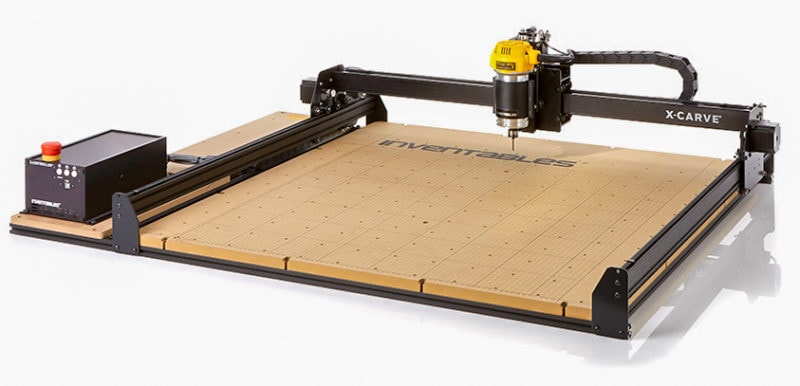
The Inventables X-Carve CNC router is a popular CNC router and is one of the best options for workshops and garages. It features a large 29.5″ x 29.5″ working area suitable for small-medium size projects. It comes as a kit, so you will need to assemble it yourself by following the documentation.
The X-Carve frame is aluminum with V-slot extrusions on the X and Y axes. These axes use a belt-driven system with a NEMA 23 stepper motor to move the assembly. This is not as precise as a lead screw drive, but it is faster. On a large machine like this, speed is often more important than pinpoint accuracy.
For cutting, the X-Carve comes with a Makita RT0701C router that’s strong and durable enough for many materials. You can CNC machine wood, acyclic, and soft metals without issues.
Included is a three-year subscription to the Inventables Easel Pro CNC software. This allows you to design, generate tool paths and control the X-carve from a single interface. This makes the X-carve especially easy to use for beginners.
Also for useful beginners (and more advanced users) is the Inventables community. It offers loads of designs, guides, and resources for your X-Carve machine. This is a big selling point, as it’s often difficult to find support and information for CNC routers.
Bundled with the X-Carve is a dust collection system. This is necessary as this CNC router will create a lot of dust when in use and it does not have an enclosure.
The inclusion of a Z-probe makes it easy to set the Z-axis zero. This is a feature that is not found on many desktop CNC machines and can save you valuable time.
The X-Carve CNC router is designed for a wide variety of professional users. The robust build quality, quality accessories, and a large working area make it suitable for engineers, woodworkers, and other professionals looking for a large desktop CNC router.
Standout Features
- Improved wasteboard
- Compact Makita high-speed router
- Excellent build quality
Technical Details |
|
|---|---|
| Working area | 749 x 749 x 114 mm |
| Footprint | 1041 x 1320 x 558 mm |
| Drive system | Belt drives |
| Router / Spindle | Makita RT0701C |
| Maximum speed | 10,000-30,000 RPM |
| Software | Easel Pro |
What We Like
- Wide material compatibility
- Lots of upgrades available
- Good community support
- Comes with dust collection system
Could Be Better
- Requires extensive assembly
- Belt drive can lead to a loss in accuracy
The Snapmaker 2.0 is a unique 3-in-1 3D printer that helps you realize all your rapid prototyping needs. It features a modular design with attachments for a CNC router, laser engraver, and a 3D printing hot end.
If you are a maker or product designer, the Snapmaker 2.0 is the perfect machine for you. It gives you the versatility to quickly switch between different projects without having to invest in multiple machines.
The Snapmaker 2.0 has a complete metal construction with a unique-looking industrial design. Despite its many functions, it comes in a form factor that is typical for a desktop CNC router.
In terms of its user interface, there is nothing to complain about. The machine has WiFi connectivity and a touchscreen that lets you control and operate your machine effortlessly. The power loss recovery feature is a practical addition that helps you avoid wasted projects in the case of accidental power outages.
The LUBAN software that comes with the Snapmaker 2.0 is an all-inclusive suite for the device. You can use it for 3D printing, laser engraving, and even CNC milling, and it makes it straightforward to prepare your files and execute them all from a single operating software. Note that you aren’t able to create designs in this software, for that you will need to use dedicated 3D modeling software.
On the Snapmaker website, you can find several options for accessories that go with the 2.0. You can choose an air-purifier, enclosure, powerful laser modules, and an emergency stop button. All these accessories are optional and not required for the functioning of your machine, but they are very useful additions and easy to install if you choose to use them.
The Snapmaker 2.0 is an excellent choice for beginners, hobbyists, and prosumers who need an all-in-one solution for their machining needs. It covers a wide range of applications and lets anyone transform their designs into reality, no matter which of its manufacturing methods you need.
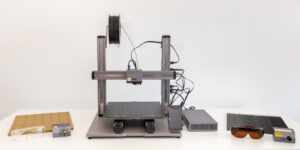
Standout Features
- 3-in-1 functionality
- 5" Smart Touchscreen
- Includes clamps and multiple bits
Technical Details |
|
|---|---|
| Working area | 320 x 350 x275 mm |
| Footprint | 495 x 506 x 580 mm |
| Drive system | Lead screw |
| Router / Spindle | Spindle |
| Maximum speed | 6,000-12,000 rpm |
| Software | Snapmaker Luban |
What We Like
- Ideal for beginners
- Covers all prototyping needs
- All-in-one control software
Could Be Better
- Low cutting speeds
- Expensive accessories
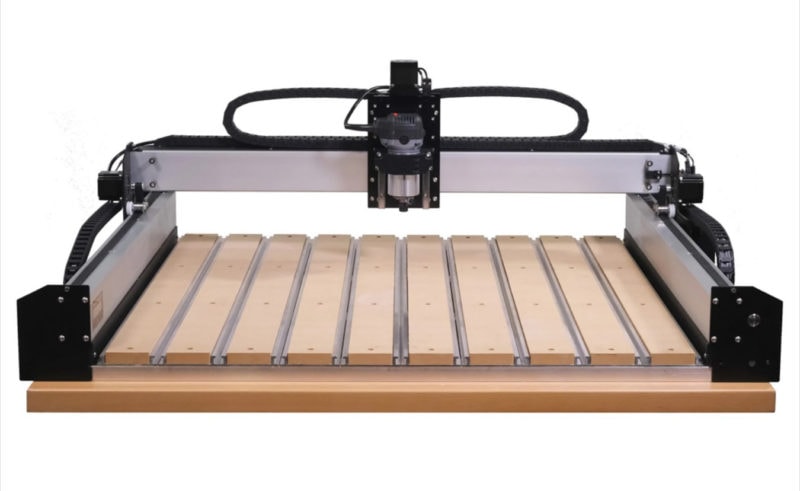
The Carbide 3D Shapeoko 4XL is one of the three variations of Shapeoko 4 CNC router machines that are available. It is an incremental upgrade over the previous Shapeoko 3 that gives you a bigger cutting area. Other improvements on the 4XL are better timing belts, inductive limit switches, and a leadscrew-driven Z-axis.
Not only that, but you also get stronger V-wheels that help with the frame’s rigidity. The thicker timing belts are 15 mm wide and are 60% stiffer than the previous 9 mm wide ones used in the Shapeoko 3.
The machine’s table comes with a redesigned hybrid waste board with T-slot rows. These allow you to attach clamps and jigs easily while still providing a flat and sturdy work surface.
Carbide3D also gives you the option to install their Carbide Compact router. This router is similar to Makita routers, except it is specifically designed to fit the Shapeoko 4.
If you wish to install your own router, the Shapeoko 4 has a 65 mm mount that can accommodate most small routers. Included with the machine is the Sweepy 65 mm V2 dust boot system as well. It will help you keep your workspace clean and dust-free regardless of the spindle you choose.
As with other Carbide CNCs, you get the Carbide Create and Carbide Motion software bundled with the Shapeoko 4. These work flawlessly with the CNC router and help you quickly design, prepare and execute your models.
The support community of the Shapeoko CNC machines is vast, and you can quickly get solutions to any problems that you might run into. Don’t underestimate the importance of a supportive community when you’re starting out with CNCs.
Overall, the big size and improved features make the Shapeoko 4 XL a suitable match for hobbyists and semi-professionals. If you are looking to CNC large wooden projects, like guitar bodies, for example, this is likely the machine for you.
Standout Features
- Hybrid T-slot table
- Inductive homing switches
- Included router mount
Technical Details |
|
|---|---|
| Working area | 838 x 444 x 102 mm |
| Footprint | 1270 x 609 x 482 mm |
| Drive system | Belt drive |
| Router / Spindle | Carbide Compact Router |
| Maximum speed | 12,000 - 30,000 |
| Software | Carbide Create |
What We Like
- Large cutting area
- Excellent dust boot system
- Easy to use software
- Rigid frame
Could Be Better
- Belt drive system
- V-wheels are easy to damage
The Genmitsu PROVerXL 4030 CNC is a workbench CNC router designed for intermediate and professional level users. It comes as a semi-assembled kit and is easy to assemble with its pre-configured axes.
Both the X and Y axes have a lead screw drive, with the Z-axis having an optical axis drive. Both of these combined guarantee high accuracy and repeatability of the router. The frame has a rigid C-beam structure that makes it easy for you to expand the work area with upgrades later on if you so desire.
The PROVerXL 4030 runs on open-source GRBL software for smooth and easy operation. Just like the 3018-PROVer, it comes with a dedicated control box to operate your machine without the need for a computer. The CNC also comes with a Carveco subscription bundled with the device, which lets you easily create personalized products for yourself, your family, or your clients.
However, Genmitsu CNC products have some downsides regarding quality control and customer support. Some users have reported faulty stepper motors and missing components in the box. The customer support, too, is not the most reliable, and you can expect to have to figure out some things on your own. Unfortunately, this is one of the downsides of going with a more affordable brand.
Yet, the Genmitsu PROVerXL 4030 is one of the best CNC routers with a powerful and rigid platform. Its large cutting area, easy assembly, and reliable performance make it a superb match for hobbyists and small-business owners looking for a relatively budget CNC router.
Standout Features
- Rigid C-frame design
- Feature-rich control box
- Easy upgradability
Technical Details |
|
|---|---|
| Working area | 400 x 300 x 110 mm |
| Footprint | 641 x 756 x 580 mm |
| Drive system | Lead screw |
| Router / Spindle | Spindle |
| Maximum speed | 12,000 RPM |
| Software | Candle, Carveco Maker, Easel |
What We Like
- Easy assembly process
- Good cable management system
- All-inclusive kit
Could Be Better
- Limited customer support
- Poor component quality

OpenBuilds CNC router machines are known for their open-source designs and affordability. The OpenBuilds LEAD CNC machine 1010 is no exception and incorporates some great features that help you with your CNC workflow.
The machine comes with a 1148 x 1148 mm (40″x40″) footprint and gives you a 730 x 810 mm (29″ x 32″) cutting area. This is a sizable work area considering its relatively affordable price of around $2000.
All axes on the OpenBuilds LEAD CNC are lead screw driven. As a result, the machine is more precise and accurate than other desktop CNC machines that use belt systems.
The NEMA 23 stepper motors are controlled using the BlackBox motion control system. It uses GRBL firmware to manage and run the CNC router. For software, the LEAD CNC comes with the OpenBuilds CAM and Control suite. Optionally, you can choose V-carve Pro or Vectric Aspire at an additional cost.
In terms of accessories, you can choose to install a dust shoe for easier cleaning and maintenance of your machine. You also have the option to install an LED ring on your spindle for a more detailed and clear view of your milling process.
As you can see, the OpenBuilds LEAD CNC is one of the most customizable desktop CNC machines that you can buy. If any of the other machines on this list are not to your liking, then this one is likely to have the perfect configuration for you.
The open-source nature, very affordable price, and future expandability make the LEAD CNC 1010 ideal for small-business owners and intermediate-level CNC enthusiasts.
Standout Features
- Open-source design
- Highly customizable
- Aluminum construction
Technical Details |
|
|---|---|
| Working area | 730 x 810 x 100 mm |
| Footprint | 1148 x 1148 x 550 mm |
| Drive system | Lead screw |
| Router / Spindle | Spindle |
| Maximum speed | 13,000 - 33,000 RPM |
| Software | OpenBuilds CAM & CONTROL |
What We Like
- Affordable
- High-quality components
- Easy to upgrade
- Great support and documentation
Could Be Better
- Extensive assembly process
What to Look for When Buying a Home CNC Machine
Table Size
The table size is the working area of a CNC router, and it denotes the space available for you to work on your materials.
Some CNC machines indicate the table size in their names themselves. For example, the 3018, 4030, 6090, and 1010 are some of the popular options available in the market. The 3018 feature indicates a working area of 300 mm x 180 mm. Similarly, a 4030 CNC router machine will have a working size of 400 mm x 300 mm.
It is essential to select the table size according to your application and workflow needs. Bigger table sizes will occupy more space in your garage, while a smaller table size will be easier for desktop applications.
In the list, the OpenBuild LEAD CNC 1010 is one of the best CNC routers with a big work area. In contrast, the Carbide3D Nomad 3 and the Snapmaker 2.0 are designed for a desktop workflow.
Footprint
The footprint of your CNC machine indicates the amount of space it will take up in your workspace. Naturally, a CNC router with a large table will have a bigger footprint and occupy more space on your workbench.
Apart from the footprint, you need to consider the space required for an offline controller box and other machine accessories. A separate offline controller requires additional space and adds to the total footprint of your CNC machine.
For example, the Genmitsu 4030 and Inventable X-Carve have a big controller that needs to be set up near the machine. On the other hand, the Carbide3D Nomad 3D and the Snapmaker 2.0 have everything built-in. These are some of the best CNC routers designed to minimize space requirements.
Material Options
The ability to cut or work on various materials is a crucial thing to consider when getting a CNC machine. Most of the CNCs mentioned in the list can efficiently work with wood, plastic, MDF, and soft metals.
If you’re getting the CNC for engraving purposes, you need to consider its material compatibility with leather, acrylic, stainless steel, and brass. These are some of the common materials used for engraving.
Cutting Speed
The cutting speed indicates the velocity of your router/spindle with respect to the workpiece. A higher cutting speed is essential when you need to finish your work quickly. Conversely, a low cutting speed is adequate for harder materials and greater control over your machining operations.
Drive System
The drive system is one of the most integral elements of your CNC machine. It directly affects the accuracy and repeatability of your CNC router. In hobbyists’ CNC machines, there are three types of commonly available drive systems.
Rack and Pinion
Rack and Pinion drives are used on more expensive CNC machines. These are very accurate and have a high degree of repeatability. A rack and pinion arrangement will allow faster speeds while requiring less overall maintenance. However, they’re not used in hobbyist CNC devices due to their bulky setup. Typically they are reserved for industrial CNC applications that require a high degree of accuracy and can justify their high cost.
Lead Screw
Lead screws are the most common drive system available for CNCs. It uses a lead screw to move the router along the axis. The benefit of lead screws is that they’re relatively inexpensive, and you don’t need to perform regular maintenance on them.
One of the main shortcomings of lead screws is that they are that accurate compared to ball screws. As a result, these are not recommended for extended travel distances and suffer from backlash issues.
Ball Screws
Ball screws can be seen as an improved version of lead screws. They offer smoother motion to our CNC router, as well as higher accuracy and enhanced precision. They are also more rigid than a traditional lead screw and are suitable for high-load bearing applications.
One reason not to go with ball screws is their high cost, this is why you typically only find them on the best CNC routers. You also need to do more frequent maintenance on them, as they need regular greasing to ensure smooth operation.
Stepper Motors vs Servos
There are different ways you can drive the axes on your desktop CNC machine. Servos and stepper motors are the most commonly used methods.
Servos have built-in rotary encoders that offer closed-loop feedback and can deliver higher torque, speeds, and load capacity. Their more complicated construction causes them to be priced higher than stepper motors.
Stepper motors, on the other hand, are more affordable and provide an open-loop control. They are also easier to operate and offer a great deal of flexibility in CNC operations. In entry-level to intermediate CNC routers, stepper motors is what you’ll always find. Not surprisingly, they offer lower speeds and lesser load-carrying abilities than servo motors.
Spindle vs Router
All CNCs either have a Spindle or a Router as their cutting end. Routers such as the Makita RT0701C and DEWALT DWP611 are commonly used in hobby CNC machines. They are a cheaper option than spindles and offer good features for their price. Their popularity also helps in finding replacement parts, accessories, and mounts for installation.
Routers are suited for occasional CNC operations with low run time. They are more accessible for beginners and easier to use than spindles, as they don’t require external circuitry to operate. As for downsides, routers are typically noisier than spindles and give you less cutting power to work with.
In contrast, a spindle on a CNC is more of a professional solution and gives you better results than a router. It is much quieter in operation and offers high cutting speeds. Their construction is also more compact than a router, so they occupy less space in the machine itself.
However, spindles require an external VFD (Variable Frequency Drive) to modulate the speed, leading to extra costs. They also tend to be more expensive than routers.
If you’re a beginner and want to get a CNC on a budget, choosing one with a router is ideal. Otherwise, a spindle CNC offers you better performance and long-duration cutting.
Dust Collection
Dust is an inevitable waste in CNC machining, and having a dust collection system or a dust shoe will drastically help you keep your workspace and the CNC clean. You need to ensure that your CNC comes with a dust cleaning accessory or that it is at least compatible with external solutions.
The Carbide3D Shapeoko 4XL comes with a dust boot included in the box, while the OpenBuilds LEAD CNC gives you the option to choose a dust shoe. In contrast, the Snapmaker 2.0 does not have any accessory for dust collection, leaving you on your own to find a compatible one.
CNC Machine Control Software
The last factor to consider when choosing the best desktop CNC machine for you is the control software. This software dictates your CNC machine’s features and capabilities. Most of the time, a manufacturer will include a specific controller software with the machine. If not, there are plenty of open-source and paid controller software in the market that you can purchase and use.
The three main tried and tested solutions of CNC router control software are Mach3, LinuxCNC, and GRBL. For desktop CNC routers with an Arduino-based microcontroller, GRBL is typically used.
As for proprietary solutions, if you want an all-in-one CAD/CAM and control software, Easel Pro by the Inventables team is the best choice out there. Snapmaker 2.0 also comes with an excellent software package that lets you control all three functions of the machine from a single application.
Kit vs Pre-Built
When you receive your CNC machine, it either comes as a kit that you need to assemble or as a pre-built machine that’s ready to use out of the box.
A CNC router kit has the advantage that you can learn a lot about the machine as you build it. However, it takes time to put together, and there’s always a risk that you might make a mistake during the assembly process.
Pre-built machines, on the other hand, can be used almost immediately after taking them out of the box. But if something goes wrong, you might have to depend on the customer support of the manufacturer to resolve the issue.
How Much Does a Hobbyist CNC Machine Cost?
The amount you end up spending on a CNC router machine depends on a number of factors. Namely, its features, build quality, and brand. If you don’t have a lot to spend, you can find machines that cost around $500. While these aren’t the best CNC routers, they still give you basic functionality, albeit with fewer features and lower build quality.
If you have more to spend, you can find desktop CNC routers for upwards of $2000. Naturally, these come with more features, as well as larger build areas, more rigidity, and other things that let you machine higher quality and larger parts without issues. But unless you have money to burn, there usually isn’t a need to immediately go for one of the best CNC routers out there.
What is the Best CNC Machine Brand?
A couple of CNC machine brands stand out from the rest. Inventables and Carbide3D are two of the best brands because they offer high-quality machines at an affordable price. Their machines are also relatively easy to use, which makes them perfect for beginners.
Is It Cheaper to Build Your Own CNC?
Building your desktop CNC machines can be significantly cheaper than purchasing a commercial model. The upfront costs of materials and components will be the biggest expense, but if you are handy with tools and have some basic machining experience, it is definitely possible to save money by building your own machine.
Keep in mind that the quality of the finished product will also depend on the quality of the CNC components you use, so it is important to do some research and purchase high-quality parts. However, if you are willing to put in the time and effort, building a CNC router can be a great way to save money.
Conclusion
The best CNC routers are the ones that fulfill your specific requirements. The needs of an individual or a business vary, and not all machines are created equal. In this comparison, there are several varieties of CNCs that suit different applications and are ideal for various situations.
The BobsCNC Evolution 4 is the winner for the overall best CNC router. It has all the essential components that you would need to execute CNC work and delivers excellent value for the money. It is a perfect fit for both beginners and more seasoned CNC hobbyists.
The Inventables X-Carve and the OpenBuilds LEAD 1010 CNC are the next best CNC routers on the list. They both have a large working area and utilize high-quality components. The X-Carve particularly stands out for its good customer and community support. Similarly, the OpenBuilds’ open-source design also comes in handy if you have any issues.
What are your experiences with CNC machines? Which one do you think is the best CNC router on the list? Let us know your answers and feedback in the comments below.
